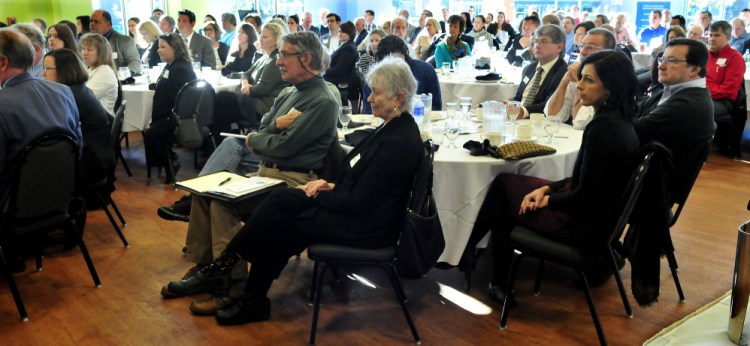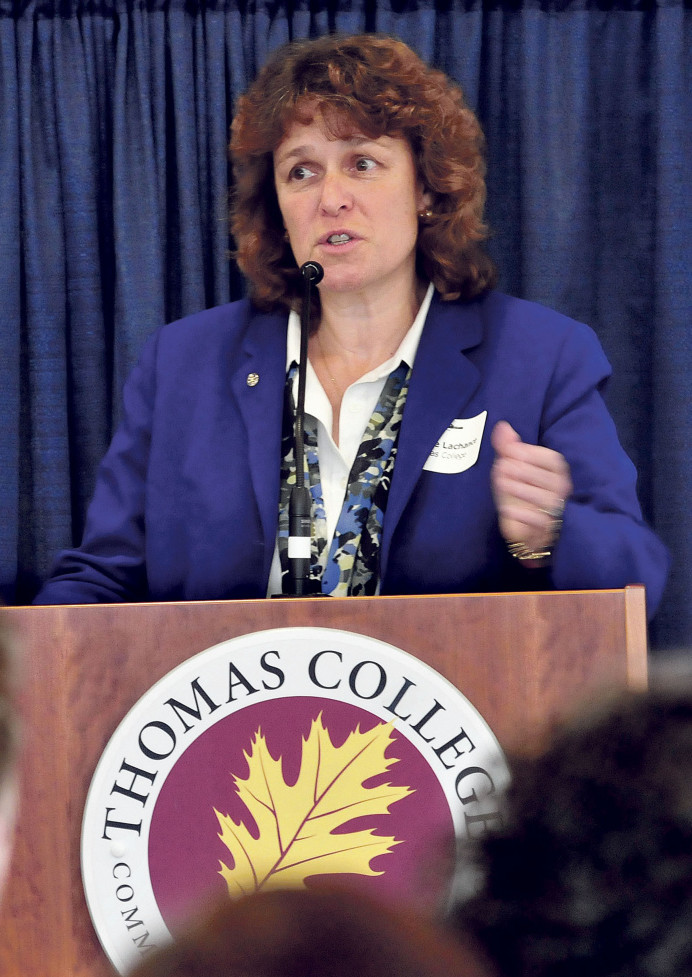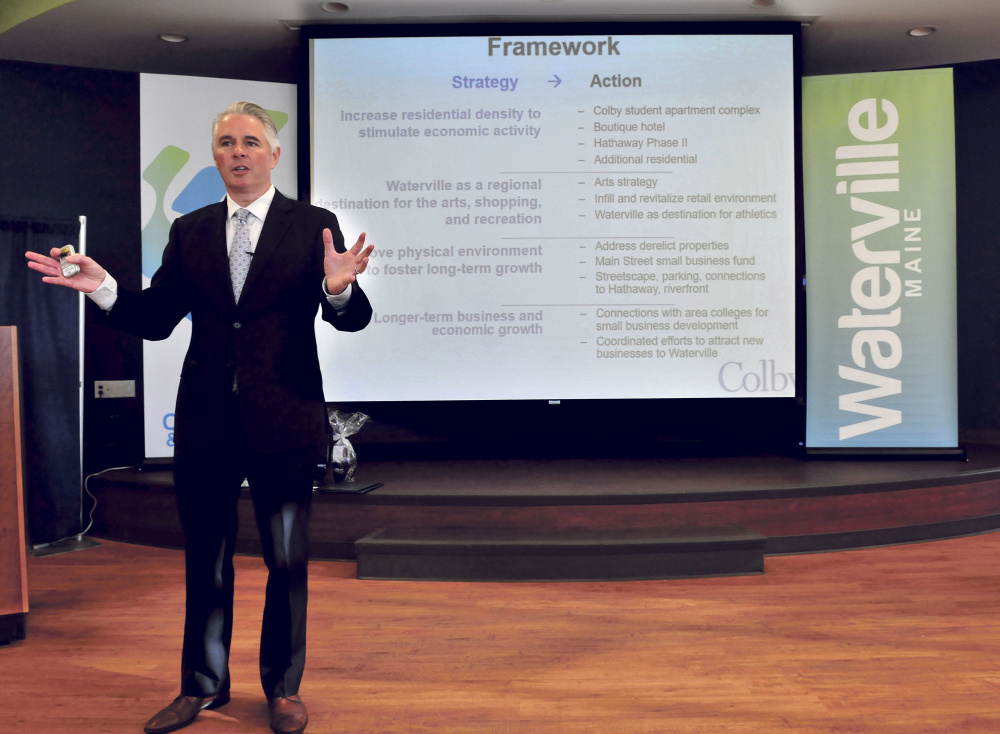WATERVILLE — Thomas College President Laurie Lachance said Thursday that the college is examining its plan for growth in ways that will benefit the larger community, as Colby College is doing with investing in the downtown.
Thomas is working with the Harold Alfond Foundation and a team of business advisers in Augusta and Waterville to examine what the college may do to complement the work Colby is doing on Main Street in Waterville, Lachance said Thursday morning at a Business Breakfast Series meeting. Thomas also has been doing basic market research about workforce issues, and officials have been traveling around the U.S. to talk to leaders in the field about family businesses and small businesses.
“We want to be able to support entrepreneurship,” she said.
Lachance and Colby President David Greene spoke about their plans at the sold-out meeting at Thomas. About 120 business leaders, educators, economic development advocates and others packed the Summit Room in the Spann Student Center for the event, sponsored by Thomas and the Mid-Maine Chamber of Commerce.
Greene talked about Colby’s partnering with the city, business professionals and groups including the chamber, Waterville Main Street and Waterville Creates! to help develop more living spaces downtown, make it more attractive for residents and businesses, enhance the arts and cultural offerings, improve connections to the riverfront and spur economic development.
Greene said he and some 20 people met over six months and identified several downtown needs, including renovating deteriorating buildings.
Colby then bought three vacant buildings downtown and plans to partner with developers and investors to renovate them. Ideas Greene’s group came up with included a boutique hotel, more retail shops, artist living spaces and galleries, and apartments for Colby faculty members and students. The students would have to apply to live downtown and to take part in civic engagement as part of the living program that would require them to tutor in schools, volunteer at social service agencies and the like.
Greene has said Colby plans to buy more property downtown. On Thursday, he said officials have been reviewing maps and looking at what could be done with an empty space on Main Street at the north end of The Concourse.
Density in the street and retail environment make all the difference, and empty spaces are detrimental, he said.
“The way that that’s broken up on the street is really kind of deadly,” he said.
Both Greene and Lachance spoke about planning campus growth to include ways to benefit the community.
For instance, Thomas three years ago opened new artificial turf fields, and thousands of community youths use it.
Thomas also shares its auditorium with the community and is one of the leaders, if not the leader, in offering dual enrollment for high school students, according to Lachance. Today, 1,200 students are taking classes in their high schools and receiving Thomas credits. Those classes are pre-certified, the curriculum has been reviewed, and the teachers certified, she said. Thomas also is committed to partnering with other colleges to create a hub for higher education, Lachance said.
She said that in the last five years, Thomas has invested $32.5 million for the new Harold Alfond Academic Center and library, a new residence hall and a major renovation of a 1970s-era building for academics and administration. The college also has added 47 employees and grown its student base 16 percent in the face of declining demographics.
Like Greene, Lachance said the colleges are merely partners in the community efforts and more are needed for them to be successful.
“You are doing it,” she said, looking out over the audience. “We’re a partner with you on this at every level.”
Greene said Colby is discussing plans for a new athletic complex on campus that could include a 50-meter pool, which would be the only Olympic-size pool in the state. Colby also is discussing building a performing arts center and currently is building an artificial turf baseball/softball field that the community will be able to use.
Greene and Lachance have been talking about how a new Colby athletic center and Thomas’ fields could benefit the community at large, including drawing large competitive events.
“If we shared our fields together, that would be a tremendous boon,” Greene said.
Greene said Colby did a rough “back-of-the envelope” calculation on how the community would benefit in terms of people staying in hotels, eating in restaurants and generating other economic benefits of such a competition, and he said it added up to well over $1 million a year.
“I think it would go up significantly from there,” he said. “I actually think arts and athletics could be real draws to Waterville.”
Citing the importance of a college’s survival to the success of the community, Greene talked about Colby’s history in the city and the symbiotic relationship between the two and how the city stepped up to help the college when it needed to raise money for a new campus. While the college six decades ago moved from downtown to Mayflower Hill, it was in some ways a disadvantage for downtown because the college became disconnected from the community.
Some people over time felt there was an air of elitism at the college, which is not what Colby is or wants, according to Greene.
“I want to make sure we break that down in a purposeful way so that it never becomes part of what we are,” he said.
He showed slides of Waterville in the past, where in the 1950s there were hotels on Main Street and a more dense population,
“People were living on Main Street. People were working on Main Street,” he said. “This was a much more vibrant place.”
In the 19th century, a lot of cities were built up and the rivers were working rivers, so cities turned their backs on the waterways, but today, that is not the case, he said.
“Now, of course, the river in most cities seems to be one of the greatest assets you have,” he said.
In addition to looking at strengthening the connection from downtown to the river, efforts are underway to help make a more pedestrian-friendly connection between downtown and the Hathaway Creative Center, he said. Hathaway has 67 high-end apartments that are full, hundreds of people working at MaineGeneral and other offices in the building, and a cafe on the main floor. Greene praised the work of Hathaway developer Paul Boghossian and said he looks forward to seeing other buildings in the complex developed.
He also cited the city’s great assets, including the Opera House, the Quarry Road Recreation Area, the medical care, the Colby College Museum of Art and the colleges and schools. In an hour, one can travel to the ocean or to the mountains, Green said.
“We are in this incredible location geographically where we are sitting in one of the most beautiful spots,” he said.
He said that when he first came to Waterville two years ago, he thought about how all those assets could be leveraged in a systematic way because if that could be done, the effort would just take off.
When he speaks with people who live in the Belgrade Lakes, some tell him they used to go to Waterville to shop and eat but now go to Augusta, he said.
“We need to change that, so we’ve been talking about how that might be an important piece,” he said.
Greene praised businessman Bill Mitchell, who bought two historic buildings on Common Street downtown and is renovating them, and restaurateur Jobi Culver, who plans to open a new wood-fired oven eatery in one of the buildings. Greene also complimented Charlie Giguere, owner of the Silver Street Tavern, who renovated spaces in one of his buildings for high-end apartments and offices, and Mayor Nick Isgro, who announced this week that he will invest in an Italian market with Candace and Tom Savinelli, owners of Holy Cannoli.
“I love it,” Greene said. “Isn’t it great? I think it’s just awesome.”
Kimberly Lindlof, the chamber’s president and chief executive officer, asked Greene about Colby’s plans to help develop a fund for downtown businesses that might need small loans for improvements. She said there was such a fund in the past, but it was difficult to get money from it.
“It was harder than going to a bank, and it was designed to be the opposite,” she said.
Greene said he did not know about that fund but said the proposed fund is needed to provide incentives for existing businesses that need a loan of $10,000 or $25,000. The fund would have to be simple to administer, he said.
Amy Calder — 861-9247
Twitter: @AmyCalder17
Send questions/comments to the editors.





